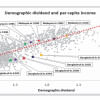Underinvestment threatens Bangladesh's demographic dividend

Bangladesh has roughly 15 years left to enjoy its first demographic dividend. But have we been able to connect all the necessary dots of developing our human capital to harness the benefits of this unique opportunity? According to the Human Capital Index by the World Bank, if a child is born in Bangladesh, they will be 46 percent productive even if they grow up enjoying complete education and full health. This percentage is lower than the South Asian and Lower Middle Income Countries' (LMIC) average of 48 percent. The youth employment scenario is not satisfactory either. According to the Quarterly Labour Force Survey 2022, around 22 percent of the youth in Bangladesh are not in education, employment or training (NEET). The crisis is more pronounced among the female youth as they comprise 65.5 percent of the total unemployed population.
The major challenge lies in prioritisation of the policies and the lack of consistent follow-up mechanisms. It is seen that while Bangladesh could make some notable achievements by focusing on the "low-hanging fruits," we could not harvest our "high-hanging fruits" much.
In the education sector, the country has attained notable success in primary school enrolment rate, achieving gender parity at the primary and secondary levels and distributing free textbooks countrywide. According to the Annual Primary School Census 2021, the net enrolment rate in primary education is 97.42 percent, with girls comprising 49.54 percent of the total enrolled. Targeted interventions like the 1993 Compulsory Primary Education Act, Food for Education, Primary Education Development Programme (PEDP) and stipend programmes contributed to this success. Along with the government interventions, a major role in this success was played by the development partners and NGOs.
On the other hand, due to a lack of timely and long-term planning, the quality of the education system has not improved much. The Human Capital Index found that the learning outcomes are severely low, especially in rural areas, reflected by 51 percent of the children not being able to read and understand a simple text by age 10. This results from a lack of deeper, systematic investment and reforms. Lack of investment is evident from the national budget. Bangladesh's education budget as a percentage of GDP has consistently hovered around or below two percent over the last 15 years, significantly falling short of UNESCO's recommended minimum investment of six percent of total GDP.
The healthcare sector shows a similar pattern. Bangladesh has had significant achievements in child immunisation, reducing maternal mortality through initiatives like the Expanded Programme on Immunisation (EPI). The initiatives were largely supported by external funding and targeted, vertical programmes. However, core systemic issues persist. We have high out-of-pocket healthcare expenditure, a critical shortage of skilled healthcare professionals, urban-rural disparities, and a growing burden of non-communicable diseases (NCDs). According to the World Health Organization (WHO), Bangladesh has only 0.7 physicians per 1,000 people, which is lower than WHO's recommended minimum of 1:1000. Combined with the lowest health spending among 45 Least Developed Countries (LDCs) in 2021, this limits the country's ability to effectively tackle critical issues like malnutrition, urban health, NCDs, and Water, Sanitation and Hygiene (WASH). To fully benefit from its demographic window, Bangladesh must ensure a healthy, skilled, and productive population through stronger, sustained investments in healthcare systems, cross-sectoral collaboration, and long-term strategic planning, which currently lack adequate prioritisation and follow-through.
In an attempt to find the impact of government prioritisation in human capital, we conducted a study titled "Impact of Government Investment in Human Capital on Harnessing Bangladesh's Demographic Dividend." Considering employment growth as an indicator for demographic dividend, the study attempted to find out whether government spending on human capital influences employment growth both in the short and long terms for Bangladesh. In the short run, increasing government spending on education leads to a significant immediate boost. For every unit increase in education spending, there is a 5.39 unit improvement, while in the long run, the impact is slightly smaller (0.24 units increase). Similarly, a one unit rise in healthcare spending results in a 10.38 unit rise in employment growth. However, there is a negative long-run effect of healthcare spending (-6.28 units).
The study result echoes the existing literature highlighting that while education and health spending yield quick returns in employment, sustaining that impact over time may require deeper structural reforms and higher investments. Without well-targeted planning, the long-term impact on employment growth will be diminishing. To improve education quality in Bangladesh, it is essential to increase national budget allocations for teacher training, curriculum update, and enhancement of employability of graduates from both tertiary and technical and vocational education systems. For health, increasing the budget in public healthcare services, hiring more nurses and doctors, emphasising nutrition for children, etc needs a much bigger focus.
Overall, Bangladesh needs to spend more on capacity-building to improve human capital, like training, research, and hiring more skilled professionals, rather than heavily investing in building infrastructure. Rather than focusing on achieving quick wins, we need to undertake structural, high-impact reforms to avoid stagnation despite early successes. A clear roadmap, political commitment, and evidence-based policymaking, along with higher public spending, are essential to translate short-term gains into sustainable development.
Shafa Tasneem is research associate at the South Asian Network on Economic Modeling (SANEM). She can be reached at [email protected].
Views expressed in this article are the author's own.
Follow The Daily Star Opinion on Facebook for the latest opinions, commentaries and analyses by experts and professionals. To contribute your article or letter to The Daily Star Opinion, see our guidelines for submission.

 For all latest news, follow The Daily Star's Google News channel.
For all latest news, follow The Daily Star's Google News channel. 








Comments